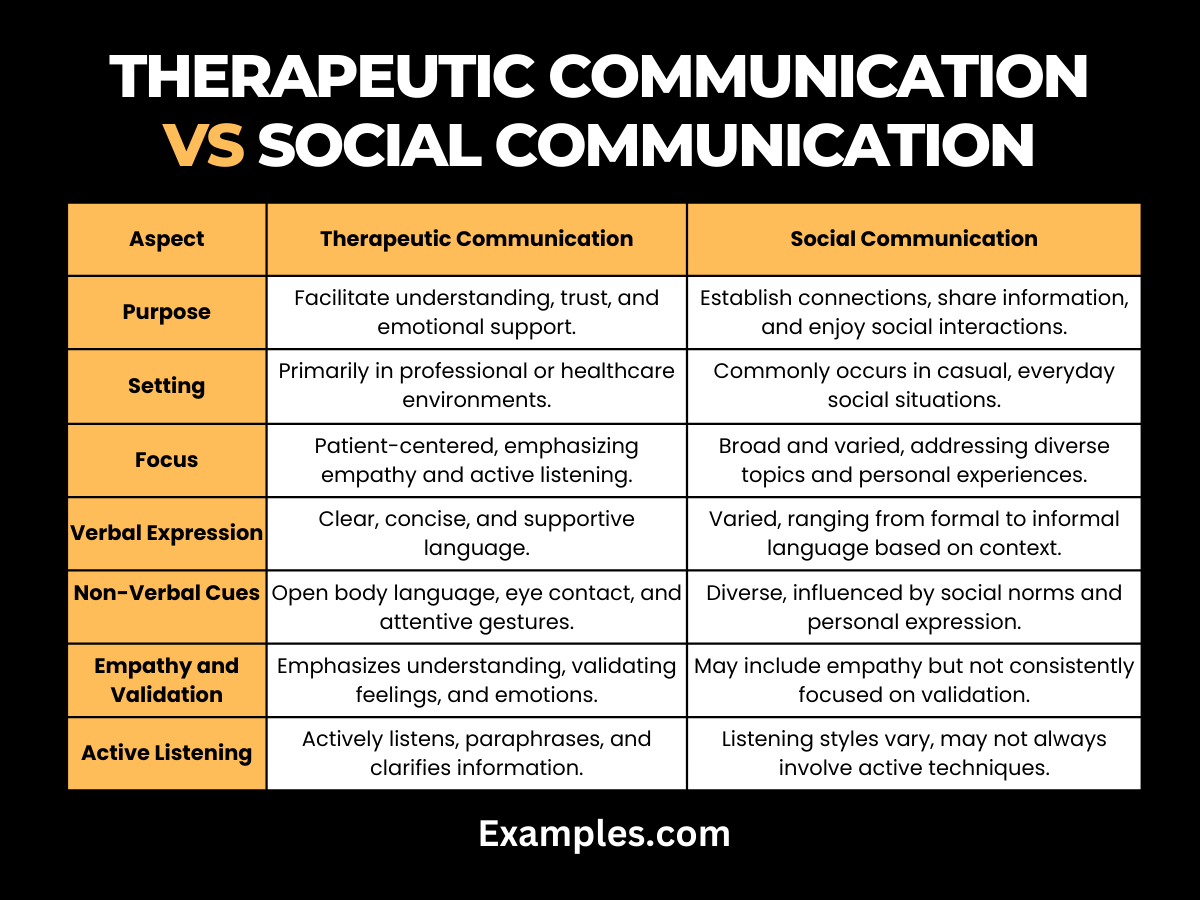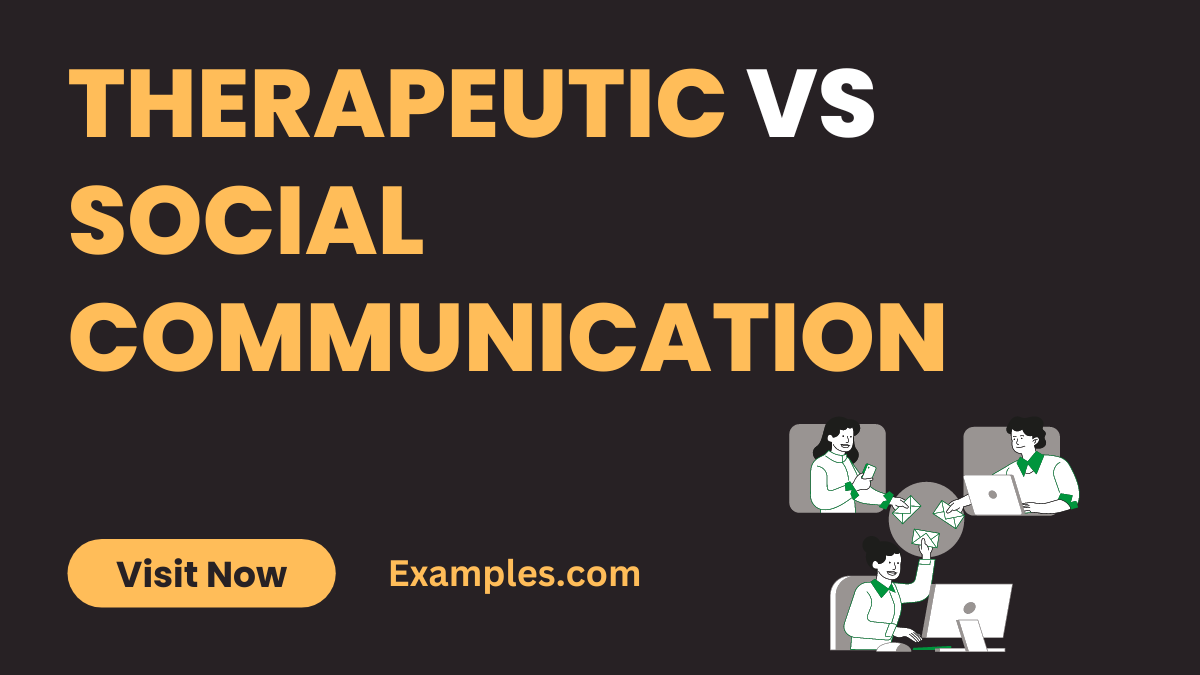Therapeutic Communication vs Social Communication – 9+ Examples
Embark on a journey through the nuanced realms of Therapeutic Communication vs Social Communication. This guide illuminates the distinctions, offering examples and practical tips to master both styles. Explore communication examples that transcend professional and casual settings, providing valuable insights to enhance your interpersonal skills. Whether in therapeutic sessions or everyday interactions, this guide equips you with the knowledge to navigate diverse social scenarios with confidence. Unlock the power of effective communication with real-world examples in this illuminating guide.
What is the difference between Therapeutic Communication and Social Communication?

Understanding the disparities between therapeutic communication and social communication is essential for effective interaction. This comprehensive table highlights the key differences:
| Aspect | Therapeutic Communication | Social Communication |
|---|---|---|
| Purpose | Facilitate understanding, trust, and emotional support. | Establish connections, share information, and enjoy social interactions. |
| Setting | Primarily in professional or healthcare environments. | Commonly occurs in casual, everyday social situations. |
| Focus | Patient-centered, emphasizing empathy and active listening. | Broad and varied, addressing diverse topics and personal experiences. |
| Verbal Expression | Clear, concise, and supportive language. | Varied, ranging from formal to informal language based on context. |
| Non-Verbal Cues | Open body language, eye contact, and attentive gestures. | Diverse, influenced by social norms and personal expression. |
| Empathy and Validation | Emphasizes understanding, validating feelings, and emotions. | May include empathy but not consistently focused on validation. |
| Active Listening | Actively listens, paraphrases, and clarifies information. | Listening styles vary, may not always involve active techniques. |
| Patient Involvement | Encourages patient participation and shared decision-making. | Involves both parties contributing to the conversation. |
| Relationship Building | Strengthens therapeutic alliances for positive outcomes. | Establishes connections for general social or work purposes. |
| Use of Silence | Utilizes purposeful silence for reflection or understanding. | Silence is context-dependent, not always intentional. |
| Feedback and Reflection | Provides constructive feedback, fostering growth. | Feedback styles may vary, ranging from constructive to casual. |
| Cultural Sensitivity | Demonstrates cultural competence and sensitivity. | Cultural sensitivity may vary based on individuals involved. |
Understanding these distinctions enables individuals to adapt their communication style based on context, fostering effective interactions in both therapeutic and social scenarios.
10 Therapeutic Communication Examples
Explore therapeutic communication examples designed to foster understanding and connection. Each example is meticulously crafted to enhance your communication skills in diverse contexts, from healthcare to daily interactions. Elevate your ability to empathize, listen actively, and support others effectively.
- Active Listening:
Example: Engage with empathy, saying boldly, “I hear your concerns; let’s discuss how we can address them.” - Empathetic Responses:
Example: Demonstrate understanding, “I can see this situation is challenging for you; I’m here to support.” - Open-Ended Questions:
Example: Encourage sharing, “Can you elaborate on how you’ve been feeling lately?” - Reflective Techniques:
Example: Use reflection, “It seems like you’re feeling overwhelmed; tell me more about it.” - Cultural Sensitivity:
Example: Acknowledge diversity, “I appreciate your perspective; let’s align our approach with your cultural preferences.” - Silence as Support:
Example: Provide reflection time, “Take your time; I’m here whenever you’re ready to talk.” - Validation of Feelings:
Example: Acknowledge emotions, “Your feelings are valid; let’s work through this together.” - Positive Reinforcement:
Example: Recognize efforts, “I noticed your dedication; it’s making a positive impact.” - Clarification:
Example: Ensure understanding, “Let me confirm I grasp what you’re saying…” - Problem-Solving Collaboration:
Example: Collaborate on solutions, “Let’s brainstorm together for a solution that suits both of us.”
These therapeutic communication examples empower you to establish connections, provide support, and contribute to positive outcomes in various interpersonal interactions.
10 Social Communication Examples
Explore social communication examples tailored for seamless interactions in various settings. Each example is thoughtfully designed to enhance your ability to connect, engage, and navigate social dynamics effectively. Elevate your interpersonal skills and make a lasting impression in casual conversations and social gatherings.
- Casual Greetings:
Example: Kick off conversations warmly, saying boldly, “Hello, how are you today?” - Sharing Information:
Example: Convey facts directly, “The event is at 7 PM in the community center.” - Expressing Opinions:
Example: Share your viewpoint straightforwardly, “I think this movie is fantastic.” - Giving Compliments:
Example: Offer sincere compliments, “Your outfit looks amazing today.” - Thanking Someone:
Example: Express gratitude, “Thank you for your help; it means a lot.” - Apologizing:
Example: Acknowledge mistakes, “I’m sorry if my comment was insensitive.” - Requesting Information:
Example: Seek details politely, “Could you tell me more about your project?” - Setting Plans:
Example: Make plans confidently, “Let’s grab coffee next week.” - Small Talk:
Example: Engage casually, “How was your weekend? Any exciting plans?” - Sharing Personal News:
Example: Inform others, “I got a promotion at work; I’m thrilled.”
These social communication examples empower you to navigate everyday interactions with ease, making positive and memorable connections in various social settings.
What is the Comparison between Therapeutic Communication and Social Communication?
Understanding the distinctions between therapeutic and social communication is essential for effective interactions. This detailed guide provides a comprehensive comparison in a tabular format:
| Aspect | Therapeutic Communication | Social Communication |
|---|---|---|
| Purpose | Facilitates understanding, support, and positive outcomes. | Promotes social connections, casual interactions, and sharing. |
| Focus | Patient-centered, emphasizing empathy and active listening. | Diverse, centered around social relationships and casual exchanges. |
| Verbal Style | Clear, concise, and supportive language. | Varied, ranging from formal to informal language depending on context. |
| Non-Verbal Cues | Open body language, eye contact, and attentive gestures. | Adaptable, influenced by the social context and individual preferences. |
| Empathy and Validation | Emphasizes understanding, validating feelings, and emotions. | May include empathy but may not consistently focus on validation. |
| Active Listening | Actively listens, paraphrases, and clarifies information. | Listening styles vary, may not always involve active techniques. |
| Patient Involvement | Encourages patient participation and shared decision-making. | Involves both parties contributing to the conversation and social dynamics. |
| Relationship Building | Strengthens therapeutic alliances for positive outcomes. | Establishes connections for general social or work-related purposes. |
| Use of Silence | Utilizes purposeful silence for reflection or understanding. | Silence is context-dependent, may occur naturally in social pauses. |
| Feedback and Reflection | Provides constructive feedback, fostering growth. | Feedback styles may vary, ranging from formal evaluations to casual remarks. |
| Cultural Sensitivity | Demonstrates cultural competence and sensitivity. | Cultural sensitivity may vary based on the social context and individuals involved. |
This comprehensive guide empowers individuals to navigate both therapeutic and social communication effectively, fostering positive outcomes in diverse interpersonal scenarios.
What is the Relationship between Therapeutic Communication and Social Communication?
In navigating interpersonal dynamics, comprehending the nuances between therapeutic and social communication is essential. This comprehensive guide delves into the distinct aspects that define the relationship between these two communication styles.
| Aspect | Therapeutic Communication | Social Communication |
|---|---|---|
| Purpose | Focused on healing, support, and understanding in professional settings. | Geared towards building connections, sharing information, and socializing. |
| Goal | Aims to promote trust, empathy, and positive outcomes in therapeutic contexts. | Seeks to establish rapport, engage socially, and enjoy shared experiences. |
| Setting | Primarily in healthcare, counseling, or supportive environments. | Encompasses a broad range of settings, from casual gatherings to formal events. |
| Verbal Expression | Emphasizes clarity, supportive language, and active listening skills. | Allows for varied expression, from casual banter to more formal speech as needed. |
| Non-Verbal Cues | Open body language, focused eye contact, and empathetic gestures. | Diverse and context-dependent, encompassing a wide range of gestures and expressions. |
| Empathy and Validation | Prioritizes understanding and validating emotions and feelings. | May include empathy but may not consistently focus on validation in every interaction. |
| Active Listening | Actively engages in listening, paraphrasing, and clarifying information. | Listening styles vary, with a focus on understanding in social contexts. |
| Patient Involvement | Encourages patient participation and shared decision-making in professional settings. | Involves both parties contributing to the conversation in a more egalitarian manner. |
| Relationship Building | Strengthens therapeutic alliances for positive outcomes. | Establishes connections for general social or work-related purposes. |
| Use of Silence | Utilizes purposeful silence for reflection or understanding. | Silence is context-dependent, may occur naturally, and serves various purposes. |
| Feedback and Reflection | Provides constructive feedback, fostering personal growth. | Feedback styles may vary, ranging from constructive to casual in social interactions. |
| Cultural Sensitivity | Demonstrates cultural competence and sensitivity in diverse contexts. | Cultural sensitivity may vary based on individuals involved in social interactions. |
This guide aims to illuminate the intricate relationship between therapeutic and social communication, offering insights to adapt communication styles based on context and desired outcomes. Understanding these distinctions enhances your ability to navigate diverse social scenarios effectively.
In conclusion, the distinction between therapeutic and social communication is pivotal in fostering effective interpersonal interactions. Therapeutic communication, primarily utilized in professional healthcare settings, focuses on empathy, patient-centered approaches, and active listening to build trust and provide emotional support. Conversely, social communication, prevalent in everyday casual interactions, involves sharing information, establishing connections, and enjoying social exchanges with a broader and varied focus.



